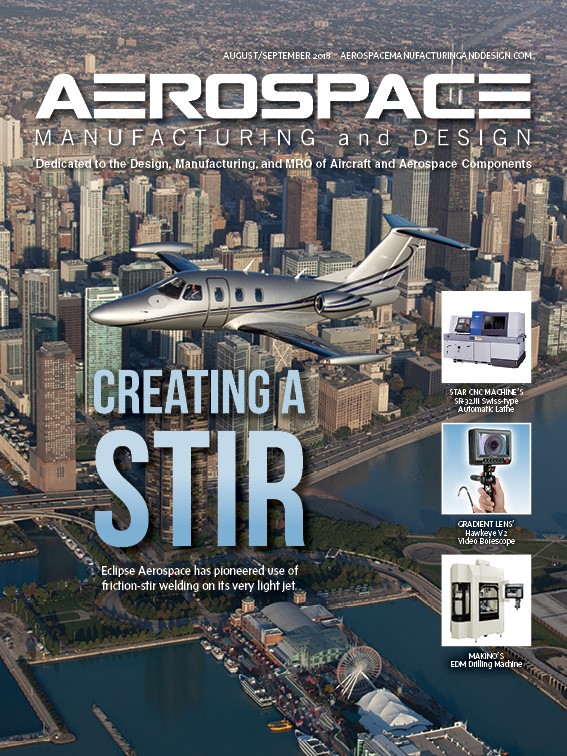
The Eclipse 550 very light jet boasts best-in-class performance, economics, and safety – meeting the design team’s goal of producing a twin-engine jet that could outperform a single-engine turboprop plane while lowering operational costs. Flying at up to 41,000ft at a max. cruise speed of 430mph while consuming only 59 gallons of fuel per hour, the Eclipse 550 is one of the most efficient small, twin-engine jets available today.
Friction-stir welding
One reason for this performance is the planes are assembled using friction-stir welding, a green manufacturing process that uses a spinning tool to push two sheets of metal together. Stirring the metals together without melting either base metal plate is faster and more rigid than heat-based welding, says Rick Davis, aircraft delivery manager for Eclipse Aerospace Inc., the current name of the company that began as Eclipse Aviation in 1998.
Friction-stir welding, a solid-state joining process, uses a non-consumable tool to join two workpieces without melting the workpiece material. The tool traverses the joint line, mechanically intermixing the two pieces of hot and softened metal with the tool’s mechanical pressure.
“It’s not really welding, but a continuous forging process – it forges two pieces of metal together in a thin line that has the appearance of a weld,” Davis explains, adding that friction-stir welding is also stronger than riveted construction.
“Eclipse Aviation and Eclipse Aerospace are the only companies that have used friction-stir welding in the aviation industry,” Davis says. The equipment was custom-made. “Everything was purpose-built by Eclipse Aviation – the gantry frame, the component assembly, and the controllers.”

Alignment is critical in friction-stir welding, so manufacturing teams use custom fixturing and molds to clamp pieces into position before joining.
“Because of the pressure used in the friction-stir welding process, these fixtures are substantial and require careful setup and alignment,” Davis explains.
The friction-stir welding process allows significantly faster build times and a lighter, stronger fuselage and wing.
“In time savings alone, a fuselage can be produced in one fifth the time as a traditionally constructed fuselage,” Davis claims. “Similar time savings were achieved with construction of the wings.”
Originally used on the Eclipse 500, friction-stir welding helped assemble the successor model, the Eclipse 550, which featured upgraded avionics and improved interior fittings.
Project Canada
Despite the Eclipse 500/550’s success, the market for very light jets collapsed during the Great Recession, just as the company was planning a new variant of the twin-engine jet (see Production history sidebar on p. 38 for more details).
Project Canada – also known as the Eclipse 700 – offers a shorter takeoff, longer range, faster climb, and improved cruise – due to a redesigned, larger wing with more fuel capacity. The 700 will increase the cabin length of the 550 by 14" and feature the latest glass-panel avionics and cabin electronic systems.
It will also use friction-stir welding for its assembly, Davis says. The production goal is 50 planes per year, although the process could make thousands per year possible. But producing the first 700 and restarting 550 production must await approval of the company’s newest owners. Meanwhile, maintaining the current fleet is the main priority, and that requires trained technicians.


Technicians needed
Davis emphasizes the industry’s need for continuing to recruit people to maintain aircraft, including light jets.
“A lot is being done at the community college level to get people into the trade. There’s a lot of opportunity, and we’ll see vocational-tech schools start up to fill the need for welding, machining, and maintenance.”
ONE Aviation
www.oneaviation.aero



Explore the August September 2018 Issue
Check out more from this issue and find your next story to read.
Latest from Aerospace Manufacturing and Design
- Upcoming webinar to highlight the rise of electric vehicles
- JEKTA, ZeroAvia partner on hydrogen-electric amphibious aircraft
- Mastercam 2025 software
- IMTS 2024 Conference: Cutting Edge Innovations: Maximizing Productivity and Best Practices with Superabrasives
- Eve Air Mobility unveils first full-scale eVTOL prototype
- Dillon Manufacturing's Fast-Trac Jaw Nuts
- IMTS 2024 Conference: Breaking the Tradeoff: Utilizing Deep Learning AI with X-ray Computed Tomography for Unparalleled Clarity and Speed
- #47 - Manufacturing Matters - The Ins and Outs of CMMC 2.0 with Smithers Information Security Services





